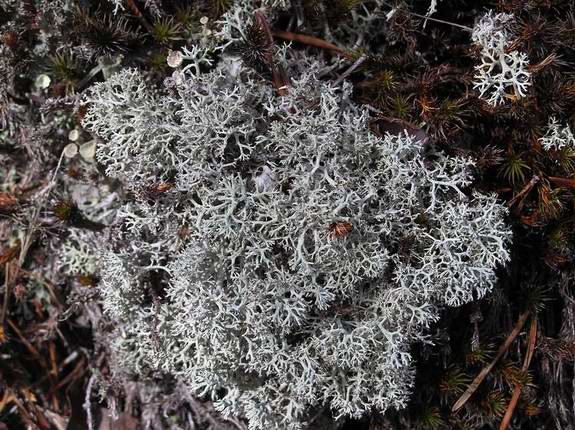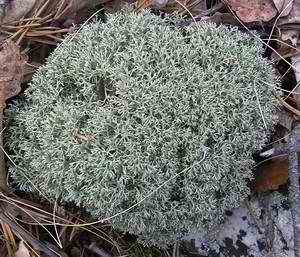|
Return to Hiker's Notebook Home Page
Common Name: Reindeer Lichen, Reindeer moss, Caribou moss, Reindeer moss lichen - The lichen is one of the primary food sources for reindeer (Rangifer tarandus); their North American counterparts are called caribou. The lichen's highly branched growth pattern known as fruticose is similar in appearance to moss.
Scientific Name: Cladonia rangiferina - The generic name is from the Greek kladon which means "sprout" to signify the shrub-like appearance of the branching segments of the lichen. The species name is taken from the reindeer/caribou genus, Rangifer. The reindeer lichens are sometimes taxonomically assigned to their own genus Cladina.
A lichen is a mutualistic combination of a fungus and an alga; mutualism is a type of symbiosis in which both entities share in the benefits of the association. Lichens thrive in relatively extreme environmental habitats due to the successful combination of attributes, the mycobiont fungus provides moisture and minerals and the photobiont alga provides photosynthetic nutrition. One fifth of all fungi or about 20,000 species exist only as lichens; they do not occur without algae. The fungal constituent of the lichen physically predominates over its algal partner, comprising about 90 percent of the overall biomass; it forms the primary structure or thallus of the lichen that anchors it to a substrate and absorbs water and minerals from the environment for sustainment. Because of this primacy, the lichen is named for the fungus. The photobiont alga of the reindeer lichen is Trebouxia erici, one of the green algae. Unlike their myriad mycobiont associates, 90 percent of all photobionts come from only three genera, Trebouxia, a unicellular green alga genus, Trentepohlia, a filamentous green alga and Nostoc, a cyanobacterium (formerly called blue green alga). Though the photobionts have the ability to exist in the natural environment without their fungal symbionts, they are rarely found; free-living populations of Trebouxia have never been found. Syllogistic logic would conclude that the algae and fungi of the lichen are totally dependent on their mutualism for survival.
The regeneration of reindeer lichen in particular and lichen in general afford some seemingly insurmountable obstacles in consideration of the paucity of resources available in their habitat and the lack of any naturally occurring constituent fungi and algae. These constraints impose a potential reproductive impasse that is resolved by vegetative regeneration, a form of asexual reproduction in which portions of the existing growth (vegetation) provide the genetics for replication. However, rather than a piece of the lichen thallus (containing both algal and fungal cells) breaking off and starting a new growth, it is more common for the lichen to form specialized structures that contain undifferentiated cells of each constituent. There are a number of different vegetative reproductive structures that are employed to this end; for lichens in the Cladonia genus, small balls of fungal hyphae called soredia enclose several algal cells. The soredia are dispersed by wind, water or animals just like the spores of the fungus would be. Once a reindeer lichen is established in a new location, slow growth is balanced by longevity; a growth rate of about 8 mm/year over an average century-long lifetime. The dominance of reindeer lichen in the boreal forest regions is evidence of their success in regeneration; lichen cover typically ranges between 50 and 90 percent. The lichen mats contribute to their own dominance by intercepting the rainfall, thereby inhibiting the germination of the seeds of any alternative species. Seedlings that do manage to survive in the soil frequently wither when the soil becomes desiccated or are pulled out by the repetitive expansions and contractions of the lichens.
Reindeer lichen is used as a general term to refer to any of several species that are consumed by the reindeer of Eurasia and the caribou of North America. The circumpolar habitat of the reindeer/caribou is congruent with that of the eponymous lichens which constitute about 90 percent of their diet in winter and about 50 percent of their diet in summer. The names of R. tarandus reflect two etymologies: Reindeer is from the Norse hreinn which is thought to derive from the word ker meaning "top of the head" - emphasizing the characteristic horns and dyr meaning animal (ergo, horn-animal); Caribou is from the Algonquian Indian word khalibu which means "that which scratches or paws." Reindeer are essentially lichen-dependent. In the seminal tome "Lichens of North America" it is recounted that caribou were introduced to Saint Matthew Island in the Bering Sea in 1943. They thrived on the indigenous lichens to the extent that the herd had expanded to about 6,000 in 1963, when the lichens ran out; only 50 survived that winter. Although other boreal ungulates (including mule deer, white-tailed deer, elk, moose and mountain goat) eat lichens, only Rangifer tarandus eat the reindeer lichens. The difference is that reindeer have developed a technique for uncovering the terrestrial lichen; they kick holes in the ice and snow to create a "crater" large enough to expose their meal. "Cratering" affords them an advantage over the competing herbivores, who must rely on arboreal lichens for sustenance. From the dietary perspective, lichens are high in carbohydrates and low in protein. Ruminants like the reindeer can break down the complex carbohydrates in the bacteria in their rumen, but they still must eat protein-rich foods to survive. In addition to grasses and shrubs, reindeer have been known to eat lemmings, bird eggs, and mushrooms.
There is some disputation concerning the taxonomy of the reindeer lichens; some lichenologists place them in the genus Cladonia with many other lichens and some afford reindeer lichens their own genus, Cladina. Both genera have hollow stalks called podetia which extend from the granular crustose (like a crust) thallus at the base in branches, an arrangement that is known as fruticose. In lichens, the thallus is the vegetative or growing portion that has both the fungal and the algal components. The difference is that reindeer lichens lack the scale-like squamules at the base of the lichen and the shiny, protective layer on the podetia called the cortex that are characteristic of the species assigned to the Cladonia genus (which are accordingly called squamulose-fruticose). However, according to the USDA, several phylogenic studies have demonstrated that DNA sequences, morphological data and chemical analyses all support the general conclusion that Cladina should be included, at least as a sub-genus in Cladonia.
There are four species of reindeer lichen that predominate in boreal latitudes
and at the higher elevations in the temperate latitudes. The most extensive is
the gray or gray-green reindeer lichen, C. rangiferina. The others are
C. arbuscula, shrubby or tree reindeer lichen, C. mitis, green
or yellow reindeer lichen and C. stellaris, star or star-tipped
reindeer lichen. They are all eaten by reindeer, but their use by humans to
some extent varies according to the species. C. rangiferina was used by
Northern native people to make medicinal tea for the treatment of colds and
fever and as a poultice for arthritic joints. It was used as fodder for cattle
in Northern Europe as a means of improving the quality and quantity of the
milk. C. arbuscula and C. mitis are nearly identical in
appearance and can only be distinguished by chemical analysis (which is true
of many lichen species) or, according to experienced lichenologists, by taste
(C. mitis is mild and C. arbuscula is bitter). The Cree Indians
used the green reindeer lichens in a manner similar to the Nordic natives for
medicinal teas, specifically for the expulsion of intestinal worms. In
general, reindeer lichen do not provide any significant nutritional benefit to
humans, as they lack the reindeer's stomach enzymes necessary to break down
the complex carbohydrates. However, native peoples did eat the partially
digested lichens in the stomachs of freshly killed reindeer, sometimes mixing
it with |

 meat scraps and blood to make a nutritious and highly esteemed pudding.
Whereas C. rangiferina and C. mitis are pioneering lichens in
that they establish colonies on nearly bare rock (a very thin layer of soil is
beneficial), C. stellaris is a climax species that gradually
predominates in mature lichen habitats. Star reindeer lichen are highly
regular with delicate branches that closely resemble miniature trees (see
photo at right). They are the primary type of lichen used for miniature trees
to add realism to model train panoramas and architectural maquettes. They are
also used to make wreaths for graveyards and for other decorations.
meat scraps and blood to make a nutritious and highly esteemed pudding.
Whereas C. rangiferina and C. mitis are pioneering lichens in
that they establish colonies on nearly bare rock (a very thin layer of soil is
beneficial), C. stellaris is a climax species that gradually
predominates in mature lichen habitats. Star reindeer lichen are highly
regular with delicate branches that closely resemble miniature trees (see
photo at right). They are the primary type of lichen used for miniature trees
to add realism to model train panoramas and architectural maquettes. They are
also used to make wreaths for graveyards and for other decorations.